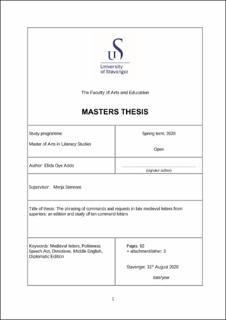| dc.contributor.advisor | Stenroos, Merja | |
| dc.contributor.author | Addo, Elida Oye | |
| dc.date.accessioned | 2020-10-27T12:17:26Z | |
| dc.date.available | 2020-10-27T12:17:26Z | |
| dc.date.issued | 2020-08-31 | |
| dc.identifier.uri | https://hdl.handle.net/11250/2685252 | |
| dc.description | Master's thesis in Literacy Studies | en_US |
| dc.description.abstract | The thesis presents an edition and study of ten late medieval letters from the late 15th century and early 16th century. The texts are dated to the period 1458–1504. All the letters may be classified as command letters, as they involve a command or request from a social superior. The phrasing of the command or request is based on the social context, distance, status and the relationship between the addresser and the addressee. This study shows a varied picture of the command letter as a genre and the phrasing of directives from superiors to their subordinates and members of the nobility.
The thesis is divided into two parts: the study and the edition. The first part gives the historical background of the study, the theoretical background, a description of the physical makeup of the manuscripts and the analysis of the texts based on their form and content. Directness is analysed on the basis of two major theories within historical pragmatics: Politeness theory and Speech act theory.
The second part presents a diplomatic edition of the ten late medieval texts. The edition includes a transcription and a translation of the texts.
The study shows that the letters follow the formulae and structure based on the ars dictaminis or ars dictandi, but that there is much variation. Letters from superiors to subordinates involving a large social distance tend to be blunt and direct, while correspondences between approximate equals are more polite and avoids offensive utterances to get their requests granted. Situational context and the kind of request are other variables affecting the use of politeness. Command letters mainly perform the function of an appellative which is to provoke the addressee to perform an action in the future.
The study contributes to our understanding of how letter writing conventions have developed over the period of time as well as making available a group of interesting historical documents. | en_US |
| dc.language.iso | eng | en_US |
| dc.publisher | University of Stavanger, Norway | en_US |
| dc.relation.ispartofseries | Masteroppgave/UIS-HF-IKS/2020; | |
| dc.rights | Attribution-NoDerivatives 4.0 Internasjonal | * |
| dc.rights.uri | http://creativecommons.org/licenses/by-nd/4.0/deed.no | * |
| dc.subject | lesevitenskap | en_US |
| dc.subject | medieval letters | en_US |
| dc.subject | politeness | en_US |
| dc.subject | directives | en_US |
| dc.subject | literacy studies | en_US |
| dc.subject | middelalderlitteratur | en_US |
| dc.subject | diplomatic edition | en_US |
| dc.title | The phrasing of commands and requests in late medieval letters from superiors: an edition and study of ten command letters | en_US |
| dc.type | Master thesis | en_US |
| dc.subject.nsi | VDP::Humaniora: 000::Litteraturvitenskapelige fag: 040::Engelsk litteratur: 043 | en_US |

